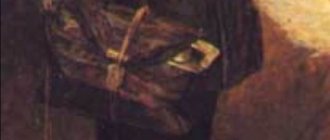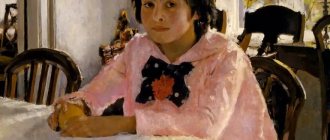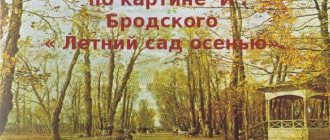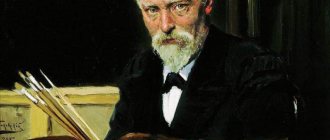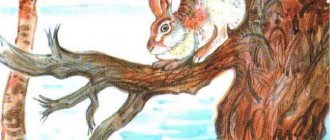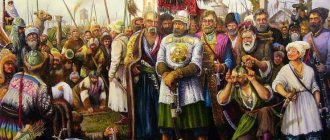- Essays
- According to paintings
- Reshetnikov
/
/
The painting “Boys” by Fyodor Pavlovich Reshetnikov depicts three boys. The painting was painted by the artist in 1971.
Most likely, the painting depicts summer. Most likely it is the end of August. The nights are already getting dark at this time of year. In the very center of the picture are three friends. They stand on the roof of a multi-story building and look enthusiastically into the sky. Multi-storey buildings can be seen below, which suggests that the boys are in the city. There is a light on in the windows of the houses, in almost every window. It follows from this that it is not very late in the day. The two boys are wearing long-sleeved sweaters, which indicates that it is cool outside. The boys in this picture are approximately 9 years old. All children, especially boys, love adventure at this age. Walking in the dark is also very interesting and mysterious.
One of the guys, the one in a white T-shirt, points upward, and the rest of the guys carefully peer into the sky. He probably tells them about what he recently read in a book, or maybe his dad told him some interesting story about space, planets or stars. Maybe even at school, during lessons, the teacher talked about different constellations of our universe. And now they are trying to find them in the starry sky. And at this time of year you can see the shower of stars and make your deepest wish. At the time when this picture was painted, the cherished desire of almost every boy was to become an astronaut and fly into outer space. After all, the picture was painted just 10 years after Yuri Gagarin’s flight into space. And of course, all the boys wanted to at least fly on a rocket and look out the window at our planet from space. These boys look at the sky with their eyes burning with curiosity and dream about the future. It can also be assumed that they are studying the moon. After all, during the full moon it is very beautiful and you can even see interesting patterns on its surface. Or dream that there, on the moon, perhaps the same three boys are looking at our planet.
The artist pays special attention to these boys. He placed them in the center of the picture and depicted them as completely different. He endowed each of them with his own emotions. Looking at them, you immediately get the impression that these are true friends. This is evidenced by the hand placed on the shoulder of his friend by one of the boys. And it’s immediately clear that these are not hooligans. The boys are neatly dressed, and in their eyes one can see the desire for new discoveries and knowledge.
Description 3
The painting “Boys” came from the brush of the recognized Soviet artist Fyodor Pavlovich Reshetnikov. The path to art for the future painter was predetermined from the beginning. He was born and raised in the family of an icon painter. He received his first skills as an apprentice from his older brother. He honed his skills at the workers' faculty of arts and at the Higher Art and Technical Courses of the capital. One of his teachers was Dmitry Moor, the author of popular posters. The student also did not become a “free artist”; he worked within the framework of socialist realism; Reshetnikov’s paintings were illustrated in school textbooks and distributed in large numbers as postcards.
Fyodor Pavlovich was not known as an “armchair worker.” He is one of the heroic Chelyuskinites; on a ship squeezed by ice, a twenty-six-year-old graduate of the Higher Art School supported the spirit of the expedition members with his drawings, publishing the wall newspaper “We Will Not Surrender.” His film “The Death of Chelyuskin” is incredibly documentary. The theme of the heroism of the Soviet people runs like a red thread through the artist’s work.
At the same time, Fyodor Reshetnikov is better known for his paintings where the heroes are children. His “Deuce Again” and “Arrived for Vacation” are familiar to almost everyone, and the boys from the lesser-known film of the same name evoke a sense of admiration.
In it, three boys climbed onto the roof of a high-rise building on a dark night, watching the stars. They most likely came here secretly from adults; it is unlikely that they would have been released alone at night. August. Starfall time. The children's gaze is directed to where the stars flash and go out. They definitely know the basics of astronomy in order to find familiar constellations among a myriad of luminaries. Especially the one in the center. He is the one who shows his friends something interesting. Perhaps on this mysterious night, hovering above the lights of the streets and houses of a big city, he is plotting his future route across the vastness of the Universe. The boy on the left faithfully watches his comrade; he is quite happy with the role of co-pilot. And the third boy is dreamy and thoughtful. He would agree to sing about the stars and stellar flights in verse. It is likely that he is already developing poetic lines.
“Boys” was written in 1971, every self-respecting boy then dreamed of becoming an astronaut. We prepared ourselves for this difficult profession by diligently playing sports, strengthening our will and body, and studying diligently. Losers are not allowed to become astronauts!
Other topics: ← Arrived on vacation↑ ReshetnikovDescription of the painting Again a deuce →
`
Option 1
(363 words) Fyodor Pavlovich Reshetnikov is a famous Soviet artist who devoted a lot of time and effort to revealing the theme of childhood in painting. He worked in the genre of socialist realism and responded to all socially significant events, but invariably depicted young heroes, their dreams and aspirations. His works such as “Deuce Again”, “Arrived on Vacation” and “Boys” are very famous and recognizable. I would like to talk in more detail about the last picture, painted in 1971, as it is very inspiring and motivating for success.
In the foreground of the painting “Boys” three boys, about 8-9 years old, are depicted who climbed onto the roof late in the evening. They stand and look at the starry sky. Judging by the history of its creation, the author dedicated this painting to the tenth anniversary of the successful return of Yuri Gagarin from space. Then many children dreamed of following in his footsteps and making great discoveries in this area. These boys are clearly passionate about astronomy and dream of conquering the stars. In the center stands a tall, dark-haired boy with a short haircut. He has dark eyes, dark skin. He is wearing a white shirt and black pants. In a company, he feels like a leader, so he patronizingly holds his friend by the shoulder and talks about what he has learned about the heavenly bodies. His hand is directed upward, he points it at an object of interest to everyone. The boy on the left is shorter. A blond man with blue eyes is wearing a dark blue sweater with a narrow strip of white collar and dark trousers. He leans on the railing with one hand and has the other back. He looks at the sky so enthusiastically that he even opened his mouth in surprise and delight. There is genuine interest in his eyes. On the right, the third participant in the conversation is leaning on the concrete reinforcement. He is wearing a blue jacket, a black sleeveless vest and a hat. His figure is darkened and bent. The hand is behind the ear. This pose expresses a certain fatigue and even a hint of skepticism. He's not as excited about what's going on as the others. In the background there is a dark blue sky, and multi-storey buildings with bright window lights can be seen below. The boys' faces are illuminated by a strange light from above, as if the roof were illuminated by a high lamp.
I really liked Reshetnikov’s painting “Boys”, as it greatly inspires the viewer and pleases the eye. It conveys a dream of heroism and scientific achievements. All of it is directed upward - to where new discoveries and secrets are ripening. The artist expressed the whole essence of childhood - his desire for a better future and faith in tomorrow.
Essay plan on the painting “Boys” for 5th grade:
- Introduction: general information about the author of the painting;
- Main part: description of the canvas: foreground and background;
- Conclusion: my impression of the picture.
Popular writings
- Essay-description based on the painting Young painter Firsova (4th, 5th grade)
In the world of modern technologies, intellectual property has become as protected as material property. Today there are many different ways to identify ownership - Essay based on the story of Gogol's Overcoat (7th, 8th, 9th grade)
The work “The Overcoat” is included in the collection of works by N.V. Gogol “Petersburg Tales”. The writer continues the theme of the little man, showing the existence of disadvantaged and downtrodden people whose lives end tragically. - Why do people reread some books?
— writing a book is a source of valuable information. But books and authors are different. Also, do not forget about the individuality of each person and that what you read can inspire
Description of the painting by F. Reshetnikov
Option 1
The artist F. P. Reshetnikov was very fond of painting pictures on children's themes, which he developed since the time of the Great Patriotic War. Often watching teenagers play war. It was from that day that he began to increasingly depict children in different life situations in his paintings.
Reshetnikov’s painting “Boys” was created in 1971 and is also dedicated to children. Ten years have passed since the legendary first manned space flight. All the boys dreamed of space and, as one, wanted to be like Yuri Gagarin. The picture shows three boys who climbed onto the roof of a multi-story building on an August night to watch the starry sky. As you know, in August in central Russia you can often watch a starfall and boys, seeing another falling “star”, try to make their deepest wish as quickly as possible.
Reshetnikov places all the “dreamers” in the center of the picture. However, the boys are different in character, as evidenced by their poses. One teenager leaned completely against the parapet. His friend is holding on to the railing, but the unusual height scares him a little. The one in the middle, in a friendly manner, put his hand on the shoulder of the one standing on the left and tells what he read in some book just a few days ago.
He points his hand at some particularly bright star and perhaps talks about it, especially emphasizing its name. He enjoys feeling some superiority over his comrades, which is so important at this age. The schoolboy talks with such enthusiasm that his friends, without looking up, look at the star that the narrator points to. They are a little jealous of him because he knows so much about galaxies and planets. And he also really dreams of flying on a real spaceship, on which he will definitely accomplish a feat.
His friends are already imagining that they, of course, will fly to the distant stars all together and will definitely visit this star, which is so different from the others in this dark blue sky, like soft velvet. Their eyes sparkle just like these stars, because the boys are sure that as adults they will contemplate the sky not from the height of a high-rise building, but through the window of an interplanetary space rocket. Below there will be land illuminated by the sun's rays, and not a city sparkling with lights, merging with the sky as if one whole.
In the painting Boys, the artist vividly depicts a state of passion, immersion in a dream, when everything around ceases to exist. It is such dreamers who, having matured, accomplish real feats, make great discoveries that allow humanity to move forward. The boys, with undisguised delight and childish inquisitiveness of mind, are directed towards the future, which is slowly revealing its secrets to them.
Around them the city has plunged into the night and is falling asleep in a foggy haze. Reshetnikov conveys to us the state of these guys, awakening in us childhood memories. We remember our dreams and secrets of the distant past with a certain amount of nostalgia. And these suddenly flooding memories seem to give us wings and give us the strength to go to the end - towards our dreams. After all, the more impossible the dream seems, the more interesting the path to it.
Fyodor Pavlovich himself experienced all this during an expedition on the legendary Chelyuskin. It was a heroic epic in which the true character of the Russian man was revealed. And this campaign included the same grown-up dreamers, about whom the whole world started talking back in 1934, admiring their courage.
Option 2
Fyodor Pavlovich Reshetnikov is a Soviet artist. He is a representative of a genre such as socialist realism, where reality and censorship dominate. Therefore, many of Reshetnikov’s paintings show the mood not only of the author, but of all eras as a whole.
The painting “Boys” was painted in 1971. On it we see three boys who look at the sky with delight. Perhaps they make a wish on a shooting star, or perhaps they dream of one day going into space. After all, it was then that there was a “cosmic” mood in the USSR, which was associated with Gagarin’s flight into space.
The picture is made in dark colors. The background - the starry sky is shown to us in dark blue and purple. And only three bright spots in the picture. These are three boys who are the main characters. The boy in the center points his finger to the sky. And the other two boys enthusiastically, with their mouths open, look up. And how can one not believe that they really saw something there? Be it a star, a nebula, or maybe they noticed an unidentified flying object?
One thing is clear - the boys are delighted and surprised, it is clear that they like what they saw. Maybe they tell each other tall tales about space inhabitants, or maybe they decide that someday they will go into space on a rocket. The author of the picture makes us understand that the boys have found their dream. After all, only a dreamer’s eyes can sparkle like that.
You can tell by the boys' clothes that the action takes place in the warm season. And the background tells us that night has fallen, and the boys went out onto the roof to admire and discuss their dream. The city falls asleep, and only three boys are awake. They think enthusiastically about their future and their dreams.
Reshetnikov's picture is clear to everyone. And the main idea is to show the desire and excitement of not only the boys, but also all the inhabitants of that particular time.
Essay based on the painting by Reshetnikov Boys, grade 5, version 2
This artist has a lot of paintings that he dedicated to children’s themes. For example, these include such masterpieces as “Took the Language”, “I Came for Vacation”, “Boys”. I would like to go into more detail and look at the painting “Boys”. It was drawn in 1971.
In the picture we see three boys; at night they climbed to the roof, probably secretly from their parents. They look at the sky dotted with stars. One can imagine that they are vying with each other to show each other the constellations and tell the secrets of the starry sky. Or maybe they are arguing about the star galaxy or other planets. Their faces express delight, they are looking for something there with such enthusiasm.
It seems that the guys do not notice anything that is happening around. I like this picture, it comes to life in my eyes. I want to be there, on the roof, next to the guys, and just like them, discuss the night sky. And you can discuss not only the galaxy and planets, but also share your secrets and innermost secrets. And it doesn’t matter to us at all how the artist depicts the city; for us it merges with the starry sky, and to the fore, displacing the boys.
The artist managed to show the mystery of a starry night, especially in combination with children. You involuntarily remember yourself in the summer, how you loved to admire the sunset or sunrise with friends, and also make a wish when a star falls. Few people believe in this sign, but I once made a wish. I believe in the wonders of a starry night. Thanks to the author for his work, it made me plunge into the world of childhood and feel its carefree nature. It seems to me that it is precisely such pictures that make us repeatedly relive the moments that connect us with childhood that give us the strength not to give up and move on.
Essay option 2
Fyodor Pavlovich Reshetnikov devoted a special part of his work to childhood. After all, this is a time characterized by serenity, cheerfulness and curiosity. Only during this period can we dream and imagine our future. Only after feeling and understanding each of his characters does Reshetnikov depict them in his painting. His work is quite interesting and gives food for thought. We can figure out what the boys are talking about, maybe they are arguing or talking quietly peacefully. Maybe they are looking for constellations or the polar star in the night sky. Or maybe they are watching the plane fly. Only our feelings and our perception will help us answer this question.
So in the painting “Boys” we see a warm summer evening and three mischievous boys. The entire night city is shrouded in silence. Somewhere in the apartment windows a bill is burning, the city is in full swing. Perhaps the boys hear cars passing by and people talking. But they, having climbed onto the roof of the house, look at the starry sky. Forgetting about the fear of heights, about the fact that their parents may have lost them at such a late time, they, without looking up, with their mouths open, look at the night sky.
All three characters are presented in different poses. One of them in a dark blue T-shirt leaned on the railing, the other, leaning his head, listened to the standing boy in a white shirt. He enthusiastically tells something and shows it in the sky. Either a constellation of stars, or something inexplicable, is showing interest in these boys, whose eyes sparkle with curiosity.
What is going on in the head of each of them is not clear, maybe they want to become test pilots, or astronomers, or like Gagarin, to do something fundamental for their homeland. Or maybe they are just thinking about their deepest desires and a wonderful future. They are so captivated by the magic of the sky that they are not afraid of the height at which they are located. Their eyes are filled with faith in a bright and clean future.
This picture gives food for thought. I want to dream and fantasize, thinking out the plot of the picture. All thoughts and feelings are very well understood even just by looking at the picture. Even a little, it seems that the artist himself wants to join the boys and dream about the future. Especially after viewing the picture, you remember yourself as a small child, memories pop up in your memory of how you once wanted to become an astronaut.
After getting acquainted with the work of Fyodor Pavlovich Reshetov, we see how multifaceted and sensual it is. How simple hand movements or body positions can explain an intended action. After all, looking at such pictures, you want to love, create and dream about a wonderful future and remember the good old times.
History of the painting
Fyodor Pavlovich Reshetnikov (1906−1988) is a famous Soviet artist, master of painting and graphics. He devoted most of his works to children's themes, depicting children in different life situations (“Deuce Again,” “Arrived on Vacation”). The author’s canvases reflect scenes from the lives of people of the Soviet period that are relevant in modern life. Schoolchildren recognize themselves, friends, and loved ones in the characters in the paintings.
The painting “Boys” was painted in 1971 and is dedicated to the younger generation. Ten years have passed since the first manned space flight. At that time, many children of the Soviet country connected their future with astronautics. The world of the sky, distant and alluring, was conquered by the pioneers. The guys depicted by the artist dreamed of following in their footsteps. Brief information about the canvas:
- Name. "Boys."
- Country, artist. THE USSR. Fedor Reshetnikov.
- Year of writing. 1971
- Genre. Surrealism
- Materials. Oil, canvas.
